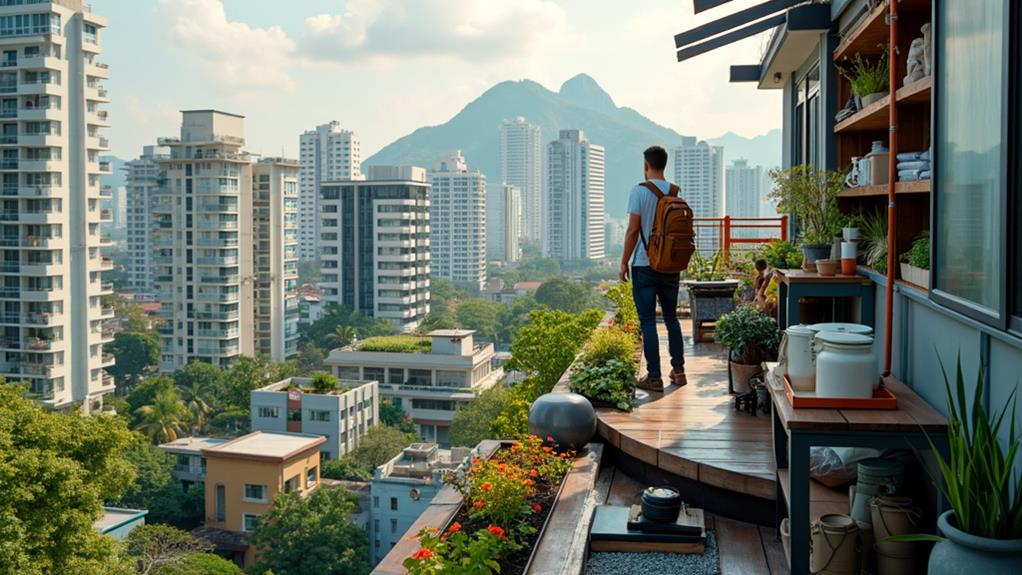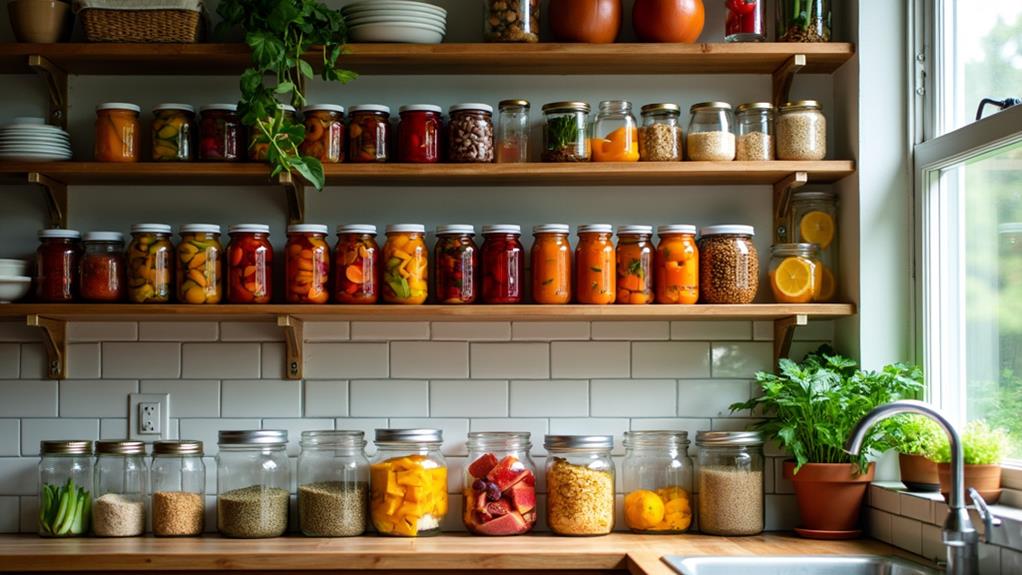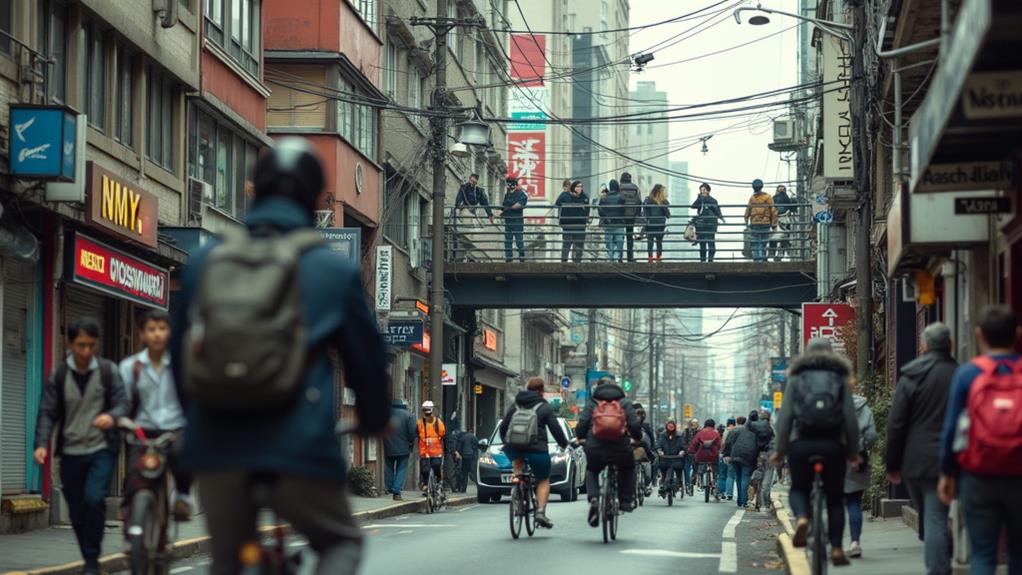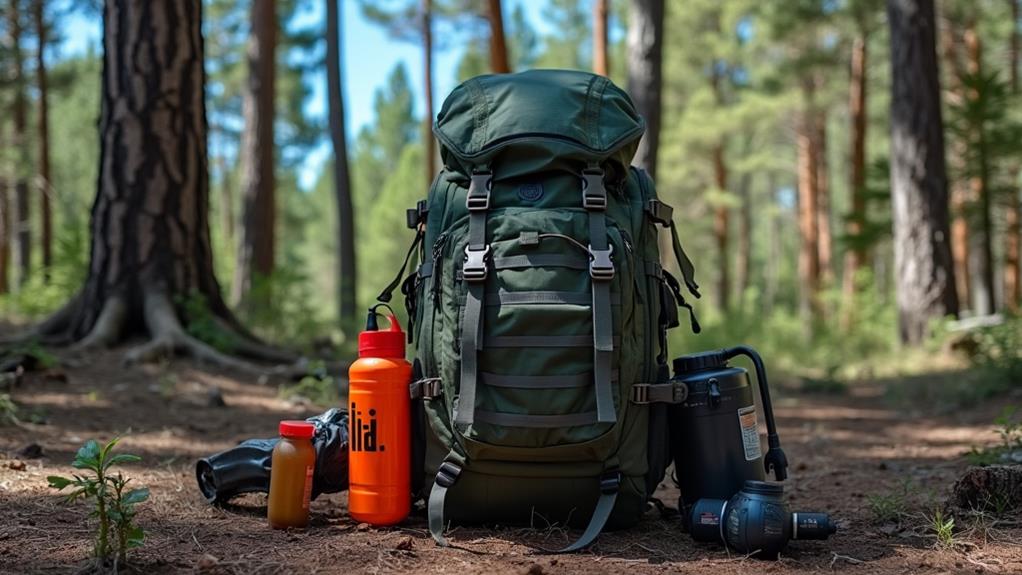How to Be a Prepper in a City?

Preparing for emergencies in an urban environment requires effective space management, such as using dual-purpose furniture and vertical storage solutions. Beyond space, stockpiling essential items like non-perishable food and water is crucial. Ensure you have methods to purify and store these supplies safely. Additionally, plan multiple evacuation routes for quick departures. These strategies are key to staying prepared for any urban emergency.
Space Management

Effective space management is essential for urban preppers to ensure adequate room for all emergency supplies. Optimize your living area by incorporating dual-purpose furniture such as beds with built-in drawers and storage ottomans. These items offer hidden storage space, ideal for food and other necessities.
For water storage, FEMA recommends at least one gallon of water per person per day for two weeks. You can creatively store smaller containers of water in nooks and crannies. Ensure you use BPA-free containers designed for long-term storage to avoid leakage issues, as milk jugs are unreliable.
Repurpose unused closet space for quick access to emergency items. Consider using 5-gallon buckets or #10 cans, which are excellent for compact living areas and can hold a variety of supplies. Vertical space solutions such as shelves or hanging organizers are perfect for keeping your emergency supplies organized and accessible, ensuring a clutter-free environment while optimizing storage space.
In urban prepping, strategic space management is crucial. By utilizing these tips, you will be well-prepared for any emergency without sacrificing your living space.
Water Storage and Treatment
Water storage and treatment are essential aspects of urban emergency preparedness. Despite limited space in a city, you can ensure you have enough clean water for emergencies. FEMA recommends storing at least one gallon of water per person per day for a minimum of two weeks, totaling 14 gallons per person. Use durable containers like food-grade buckets or BPA-free plastic bottles, and avoid milk jugs, as they can deteriorate and leak over time.
Maximize storage space by placing smaller water containers in unused areas around your home, such as under beds, in closets, or behind furniture. In a disaster, you may need to source water from unconventional places like water heaters or toilet tanks, but purification is crucial.
Invest in water filtration devices or purification tablets to treat water from uncertain sources. These tools ensure you have access to safe drinking water when the municipal supply is compromised. In an urban environment, clean water is not just a convenience—it's a necessity. Prioritize water storage and treatment in your emergency preparedness plans to be ready for any situation.
Food Storage and Preparation

To efficiently store food in your urban space, stockpile non-perishable items like freeze-dried meals and calorie-dense food bars. Utilize dual-purpose furniture to maximize storage and implement a food rotation system to maintain the freshness of your supplies. For quick meal options during emergencies, keep just-add-water meals and MREs readily available.
Efficient Food Storage
Living in a city doesn't mean you can't prepare for emergencies, especially concerning food storage. Efficient food storage is fundamental for urban survival. Start by stockpiling non-perishable items like freeze-dried meals and calorie-dense food bars. These items often have a shelf life of up to 25 years, making them ideal for emergency supplies.
Maximizing limited urban space is crucial. Utilize dual-purpose furniture and creative storage solutions, such as 5-gallon buckets, to organize bulk food supplies. Vacuum-seal dry goods to extend their shelf life and conserve space, which is particularly beneficial in tight urban environments.
Implement a food rotation system to ensure older items are used first. This practice maintains freshness and reduces waste. Keeping an inventory of your food stock is also important. Note expiration dates and quantities to avoid over-purchasing and ensure you have a sufficient supply for emergencies.
Here's a quick reference table to help you organize your food storage:
| Item | Shelf Life | Storage Method |
|---|---|---|
| Freeze-dried meals | Up to 25 years | Vacuum-sealed bags |
| Calorie-dense bars | Up to 5 years | Original packaging |
| Dried beans | 1-2 years | 5-gallon buckets |
| Canned goods | 2-5 years | Pantry shelves |
| Rice | Up to 25 years | Vacuum-sealed bags |
This guide will help you efficiently store food, making sure you are prepared for any emergency, even in a limited urban space.
Emergency Meal Options
When emergencies strike, having the right meal options can make a world of difference. As an urban prepper, you'll want to stockpile emergency food that's easy to prepare and doesn't rely on water and power. Just-add-water meals and MREs (Meals Ready-to-Eat) are ideal, as they require minimal to no cooking. High-calorie food bars should also be part of your emergency supply, providing essential energy without needing extra water.
Consider these non-perishable food items to optimize shelf life and minimize storage space:
- Freeze-dried fruits – Lightweight and nutritious.
- Canned goods – Durable and versatile.
- Vacuum-sealed snacks – Keep them fresh and space-efficient.
- High-calorie food bars – Compact and energy-dense.
Maintaining a food rotation system is essential for keeping your supplies fresh and safe to consume. By using older items first, you'll prevent waste and ensure you always have viable emergency food on hand.
Additionally, investing in a portable water filtration system can be a lifesaver during food shortages, ensuring you have clean water for rehydrating meals and staying hydrated. Don't forget to keep a first-aid kit handy to address any health issues that might arise during an emergency.
Evacuation Preparedness
When preparing for a quick evacuation, it is crucial to develop a detailed plan that includes multiple routes to safe locations, considering potential road blockages and congestion. Familiarize yourself with local emergency services and practice alternative strategies, such as walking or biking, to avoid crowded roads. Ensure you have a checklist of essential items ready, including important documents and emergency kits, so you can leave swiftly and efficiently.
Quick Evacuation Planning
In a citywide emergency, having a quick evacuation plan can be the difference between safety and danger. Begin by creating a detailed evacuation plan that includes multiple escape routes to safe locations outside the city. This prepares you for potential traffic congestion and blocked paths during a disaster. Ensure you have an emergency kit ready, packed with essential items like food, water, and medical supplies.
Identify safe meeting points for your family in case you get separated during an evacuation. Regular practice of this plan is crucial to ensure everyone is familiar with the procedures. Stay informed about local resources, such as hospitals and emergency shelters, to navigate effectively to safety. Initial responders may be overwhelmed during a crisis, so having a self-sufficient plan is essential.
Consider alternate transportation methods, such as biking or walking, especially if roads are jammed or fuel is scarce. Here's a quick checklist to help you get started:
- Multiple escape routes
- Essential emergency kit
- Safe meeting points
- Knowledge of local emergency services
- Alternate transportation methods
Alternative Evacuation Strategies
Having a quick evacuation plan is vital, but considering alternative evacuation strategies can significantly enhance your preparedness. In urban settings, traffic congestion can severely delay movement during natural disasters. To mitigate this, plan multiple evacuation routes. If one path is blocked, you will have other options available.
Leaving early is crucial. Aim to evacuate as soon as an emergency is declared to avoid crowded conditions and secure better access to resources. Consider alternative transportation methods like biking or walking, as these can often navigate through congested streets more efficiently than cars.
Prepare a checklist of essential items to take with you. Ensure your emergency kits include important documents, emergency supplies, and personal necessities, all ready for quick access. Keep these supplies on hand and easily accessible.
Involve your family in evacuation drills. Familiarize everyone with the evacuation route and ensure a coordinated response during an actual emergency. Practicing these drills enhances your survival skills and ensures everyone knows their role.
Alternative Evacuation Strategies

Navigating a city during an emergency requires a comprehensive evacuation strategy to ensure you and your loved ones reach safety efficiently. Begin by identifying multiple evacuation routes. Urban areas can become chaotic, and having alternatives ensures you are not trapped by blocked pathways. Departing early is crucial, as it reduces congestion and the stress of navigating crowded streets.
Next, stock up on emergency supplies. Ensure you have enough food and water for an extended period, as delays can occur. A solid plan includes extra provisions to keep everyone safe and nourished. Physical fitness also plays a critical role; you might need to walk or bike if roads are jammed, so being in good shape will help.
In addition to the basics, consider these strategies:
- Map out several evacuation routes to adapt to changing conditions.
- Prepare emergency supplies like first-aid kits and extra clothing.
- Keep a stash of food and water for emergencies.
- Maintain physical fitness to handle strenuous activities.
- Plan for helping injured individuals to ensure everyone's safety.
Crowds and Safety
Navigating an urban environment during an emergency requires more than just strategic evacuation routes and supplies; managing crowds and ensuring safety are equally crucial. Crowds can quickly become chaotic, leading to panic, violence, and looting. To mitigate these risks, follow evacuation orders promptly. Any delays could result in being trapped in overcrowded routes, obstructing access to essential resources and safety.
High population density in urban areas means evacuation routes can rapidly become congested. Familiarize yourself with alternative exits and escape routes from buildings. This knowledge can be vital during power outages or when standard entry points are compromised.
Having a self-defense plan is also essential. Crowded situations can escalate quickly, and basic self-defense skills can help protect you and your loved ones. Engaging with local law enforcement and community safety groups can provide valuable insights into managing crowd-related risks during emergencies.
Communication Plans

To ensure your family's safety during a crisis, create a communication plan that includes designated meeting points and emergency contact numbers. Equip yourselves with walkie-talkies or offline-capable smartphone apps to maintain communication during power outages or cell network failures. Keep an updated contact list of local neighbors and emergency services accessible to everyone in your household.
Family Communication Strategies
Navigating urban emergencies can be challenging, but a robust family communication plan can make all the difference. When chaos strikes, staying in touch with loved ones is vital. Establish a plan that includes designated meeting points and methods for contacting each other if separated. Ensure everyone knows where to go and how to reach one another.
In worst-case scenarios like power outages, offline communication apps or walkie-talkies can be lifesavers. Regularly practicing your plan through drills will help everyone remain calm and collected during actual emergencies. Additionally, maintain an easily accessible list of emergency contacts, including friends and family, to facilitate quick communication and coordination.
To enhance your preparedness, consider the following steps:
- Designate Clear Meeting Points: Ensure everyone knows where to regroup if separated.
- Use Offline Communication Tools: Have walkie-talkies or offline apps ready for power outages.
- Practice Regularly: Conduct drills to reinforce the plan.
- Share Updates with Community: Use group chats or messaging platforms for collective support.
- Keep Emergency Contacts Handy: Ensure contact details are easily accessible.
Emergency Contact List
Establishing a solid family communication strategy is just the beginning. To be fully prepared, you need an extensive emergency contact list. This list should include family members, close friends, neighbors, and local emergency services. Verify that all contacts have updated phone numbers and addresses. A well-prepared contact list is vital for staying in touch with loved ones during an emergency.
Designate primary and secondary meeting points where family members can gather. Choose locations that are easily accessible and familiar to everyone. This guarantees that even if communication fails, everyone knows where to go.
Use communication apps with offline capabilities or walkie-talkies to stay connected. Traditional networks might fail during disasters, so having alternative communication methods is essential. Regularly review and practice your emergency communication plan with your family. Reinforcing roles and responsibilities improves preparedness.
Store a physical copy of the emergency contact list and communication plan in your bug-out bag. This ensures it's always accessible, even during power outages or device failures.
| Contact | Details |
|---|---|
| Family Members | Updated phone numbers |
| Close Friends | Addresses and numbers |
| Neighbors | Contact info |
| Local Emergency Services | Phone numbers |
| Meeting Points | Primary and secondary |
Navigation Skills
Mastering wayfinding skills is essential for any urban prepper, especially during emergencies when traditional systems might fail. Navigating through a city in a crisis demands familiarity with your surroundings and readiness for unexpected scenarios. Begin by studying your city's map, focusing on critical resources like hospitals, shelters, and evacuation routes. These skills will help you move efficiently during chaotic situations.
Enhance your navigation skills by recognizing and orienting yourself with local landmarks, providing a sense of direction even in disorienting conditions. Additionally, learning to use a compass and understanding cardinal directions can be invaluable when digital devices fail due to power outages.
To ensure you're prepared, consider these steps:
- Download offline maps or navigation apps that function without internet connectivity.
- Participate in local navigation drills or community preparedness events to build practical skills and familiarity with your urban environment.
- Practice using a compass and become proficient with cardinal directions.
- Study your city's map to identify key resources and evacuation routes.
- Regularly navigate your area without relying on GPS to enhance your sense of direction.
These measures will ensure you are well-prepared to navigate your city effectively during emergencies.
Health and Sanitation

Navigating health and sanitation challenges in a city during an emergency can be daunting, but with the right preparation, you can manage effectively. Start by maintaining a supply of portable toilets and waste bags, crucial for waste management during water or power outages to prevent disease spread. In an urban setting, knowing local sanitation resources and planning for temporary waste disposal is imperative, especially if plumbing fails.
Stockpile essential sanitation supplies such as hand sanitizers, disinfectants, and personal hygiene products. These items help maintain cleanliness when access to regular facilities is limited. Familiarize yourself with emergency sanitation practices, including using biodegradable waste bags and safe waste disposal methods to reduce health risks in crowded environments.
Regularly check and replenish your supplies to ensure readiness. Your emergency kit should comply with health standards to keep you and your loved ones safe during crises.
| Vital Supplies | Purpose |
|---|---|
| Portable Toilets | Waste management |
| Hand Sanitizers | Personal hygiene |
| Biodegradable Bags | Safe waste disposal |
Community and Networking
Maintaining personal health and sanitation is crucial, but connecting with your community is equally important for collective resilience. Building a network of supportive individuals can make a significant difference during a crisis. Joining local emergency preparedness groups allows you to share resources, knowledge, and skills, enhancing your community's overall resilience.
A buddy system with neighbors can foster mutual assistance in emergencies, creating a sense of trust and support. Participating in workshops and training sessions focused on emergency preparedness helps you build a network of like-minded individuals with diverse skill sets. These sessions educate and strengthen community bonds.
Utilize social media platforms to coordinate with local groups for timely updates and information sharing, ensuring everyone is on the same page during an emergency. Engaging with local organizations like the Red Cross can provide additional support and resources, further strengthening your community ties.
- Join local emergency preparedness groups: Share resources and skills to enhance resilience.
- Create a buddy system: Foster mutual assistance and trust with neighbors.
- Attend community workshops: Build a diverse network of skilled individuals.
- Use social media: Coordinate and share timely information with local groups.
- Engage with local organizations: Access additional support and resources.




